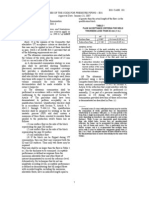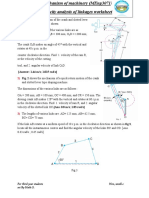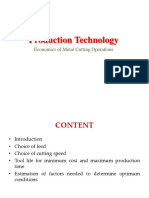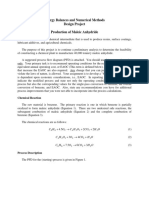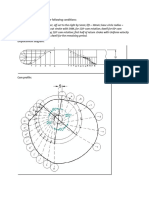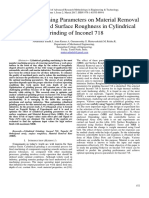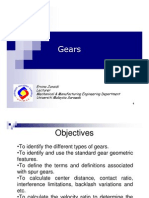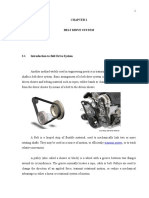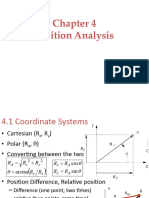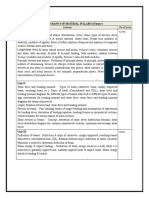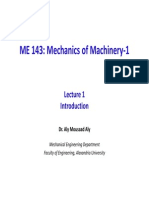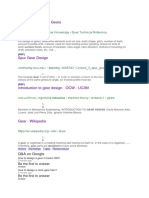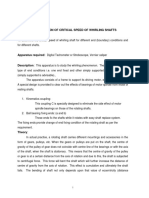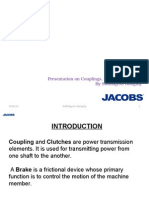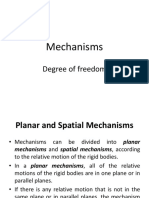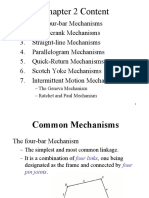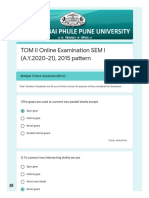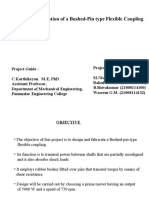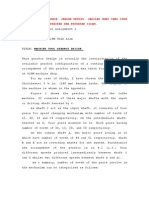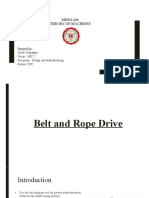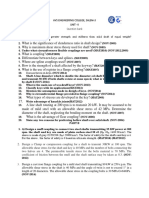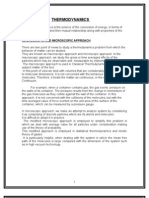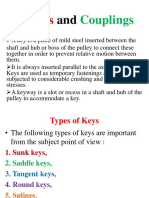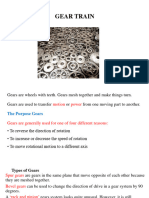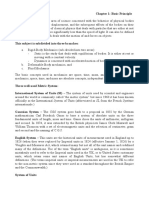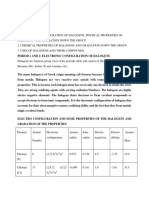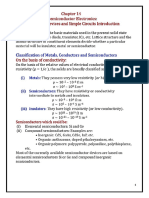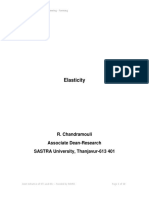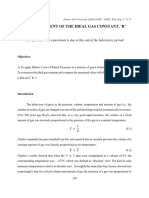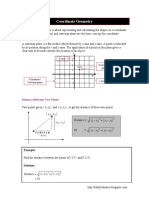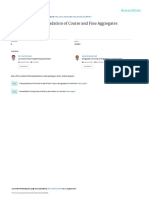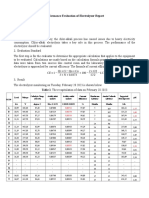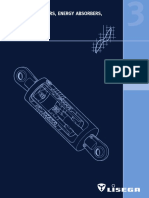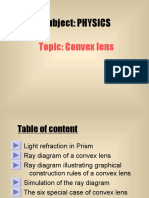0 ratings0% found this document useful (0 votes)
302 viewsGear Train
Gear Train
Uploaded by
Shiva SuprithGear trains transmit power from one shaft to another using two or more gears meshed together. There are several types of gear trains including simple, compound, reverted, and epicyclic trains. An epicyclic gear train uses planet gears that rotate around a central sun gear or internal ring gear. This allows for high speed ratios within a compact space. Epicyclic trains are used in devices such as lathes, differentials, hoists, watches, and more.
Copyright:
© All Rights Reserved
Available Formats
Download as PDF, TXT or read online from Scribd
Gear Train
Gear Train
Uploaded by
Shiva Suprith0 ratings0% found this document useful (0 votes)
302 views14 pagesGear trains transmit power from one shaft to another using two or more gears meshed together. There are several types of gear trains including simple, compound, reverted, and epicyclic trains. An epicyclic gear train uses planet gears that rotate around a central sun gear or internal ring gear. This allows for high speed ratios within a compact space. Epicyclic trains are used in devices such as lathes, differentials, hoists, watches, and more.
Copyright
© © All Rights Reserved
Available Formats
PDF, TXT or read online from Scribd
Share this document
Did you find this document useful?
Is this content inappropriate?
Gear trains transmit power from one shaft to another using two or more gears meshed together. There are several types of gear trains including simple, compound, reverted, and epicyclic trains. An epicyclic gear train uses planet gears that rotate around a central sun gear or internal ring gear. This allows for high speed ratios within a compact space. Epicyclic trains are used in devices such as lathes, differentials, hoists, watches, and more.
Copyright:
© All Rights Reserved
Available Formats
Download as PDF, TXT or read online from Scribd
Download as pdf or txt
0 ratings0% found this document useful (0 votes)
302 views14 pagesGear Train
Gear Train
Uploaded by
Shiva SuprithGear trains transmit power from one shaft to another using two or more gears meshed together. There are several types of gear trains including simple, compound, reverted, and epicyclic trains. An epicyclic gear train uses planet gears that rotate around a central sun gear or internal ring gear. This allows for high speed ratios within a compact space. Epicyclic trains are used in devices such as lathes, differentials, hoists, watches, and more.
Copyright:
© All Rights Reserved
Available Formats
Download as PDF, TXT or read online from Scribd
Download as pdf or txt
You are on page 1of 14
Gear Trains
Two or more gears are made to mesh with each other to transmit power from one shaft to
another. Such a combination is called gear train or train of toothed wheels.
Types of Gear Trains
1. Simple gear train,
2. Compound gear train,
3. Reverted gear train, and
4. Epicyclic gear train.
Simple Gear Train
When there is only one gear on each shaft it is known as simple gear train.
Distance between the two shafts is small, the two gears 1 and 2 are made to mesh with
each other to transmit motion from one shaft to the other.
the gear 1 drives the gear 2, therefore gear 1 is called the driver and the gear 2 is
called the driven or follower.
Speed ratio (or velocity ratio) of
gear train is the ratio of the speed of
N1 = Speed of gear 1(or driver) in r.p.m.,
the driver to the speed of the driven
N2 = Speed of gear 2 (or driven or follower) in r.p.m.,
or follower
T1 = Number of teeth on gear 1, and
T2 = Number of teeth on gear 2.
The distance between the two gears is large.
1. By providing the large sized gear, or 2. By providing one or more intermediate gears.
The speed ratio and the
train value, in a simple
train of gears, is
independent of the size
and number of
intermediate gears.
These intermediate gears
are called idle gears, as
they do not effect the
speed ratio or train
value of the system
Compound Gear Train
More than one gear on a shaft it is called a compound train of gear.
The advantage of a compound train over a simple
gear train is that a much larger speed
reduction from the first shaft to the last shaft can
be obtained with small gears
Reverted Gear Train When the axes of the first gear (i.e. first driver)
and the last gear (i.e. last driven or follower) are co-axial,
then the gear train is known as reverted gear train
T1 = Number of teeth on gear 1,
r1 = Pitch circle radius of gear 1, and
N1 = Speed of gear 1 in r.p.m
Distance between the centres of the shafts of gears 1 and 2 as
well as gears 3 and 4 is same r1 + r2 = r3 + r4
The circular pitch or module of all the gears is assumed
to be same T1 + T2 = T3 + T4
Epicyclic Gear Train
In an epicyclic gear train, the axes of the shafts, over which the
gears are mounted, may move relative to a fixed axis. A simple
epicyclic gear train is shown in Figure. where a gear A and the
arm C have a common axis at O1 about which they can rotate.
The gear B meshes with gear A and has its axis on the arm at O2,
about which the gear B can rotate. If the arm is fixed, the gear
train is simple and gear A can drive gear B or vice- versa, but if
gear A is fixed and the arm is rotated about the axis of gear A (i.e.
O1), then the gear B is forced to rotate upon and around gear A.
Such a motion is called epicyclic and the gear trains arranged in
such a manner that one or more of their members move upon and
around anothermember are known as epicyclic gear trains
The epicyclic gear trains are useful for transmitting high velocity ratios with gears of
moderate size in a comparatively lesser space. The epicyclic gear trains are used in the
back gear of lathe, differential gears of the automobiles, hoists, pulley blocks, wrist
watches etc.
Velocity Ratioz of Epicyclic Gear Train
In an epicyclic gear train, an arm carries two gears A and B having 36 and 45 teeth
respectively. If the arm rotates at 150 r.p.m. in the anticlockwise direction about the centre
of the gear A which is fixed, determine the speed of gear B. If the
gear A instead of being fixed, makes 300 r.p.m. in the clockwise direction, what will be the
speed of gear B ?
Solution. Given : T A = 36 ; TB = 45 ; NC = 150 r.p.m. (anticlockwise)
An epicyclic gear train consists of a sun wheel S, a stationary internal gear E and three
identical planet wheels P carried on a star- shaped planet carrier C. The size of different
toothed wheels are such that the planet carrier C rotates at 1/5th of the speed of the sunwheel
S. The minimum number of teeth on any wheel is 16. The driving torque on the sun wheel is
100 N-m. Determine : 1. number of teeth on different wheels of the train, and 2. torque
necessary to keep the internal gear stationary
A pinion has 15 teeth, and is rigidly fixed to a motor shaft. The wheel P has 20 teeth and
gears with S and also with a fixed annulus wheel A. The pinion C has 15 teeth and fixed to the
wheel P. C gears with the annular wheel D, which is keyed to a machine shaft. P and C can rotate
together on a pin carried by an arm which rotates about the shaft on which S is fixed. Find the
speed of the machine shaft if the motor rotates at 1000 rpm. (Ans. 37.15 rpm in the same
direction as S)
An epicyclic gear train, as shown in Figure, is composed of a fixed annular wheel A
having 150 teeth. The wheel A is meshing with wheel B which drives wheel D through
an idle wheel C, D being concentric with A. The wheels B and C are carried on an arm
which revolves clockwise at 100 r.p.m. about the axis of A and D. If the wheels B and D
have 25 teeth and 40 teeth respectively, find the number of teeth on C and the speed and
sense of rotation of C. (Ans. 30 ; 600 r.p.m. clockwise)
Figure, shows an epicyclic gear train with the following details :
A has 40 teeth external (fixed gear) ; B has 80 teeth internal ; C - D is a compound wheel
having 20 and 50 teeth (external) respectively, E-F is a compound wheel having 20 and 40
teeth (external) respectively, and G has 90 teeth (external). The arm runs at 100 r.p.m. in
clockwise direction. Determine the speeds for gears C, E, and B. (Ans. 300 r.p.m. clockwise ;
400 r.p.m. anticlockwise ; 150 r.p.m. clockwise)
An epicyclic reduction gear, as shown in Figure, has a shaft A fixed to arm B. The arm B
has a pin fixed to its outer end and two gears C and E which are rigidly fixed, revolve on this
pin. Gear C meshes with annular wheel D and gear E with pinion F. G is the driver pulley and
D is kept stationary. The number of teeth are: D = 80 ; C = 10 ; E = 24 and F = 18. If the
pulley G runs at 200 r.p.m.; find the speed of shaft A.
You might also like
- ASME B31 3 Code Case 181Document8 pagesASME B31 3 Code Case 181AkbarNo ratings yet
- Stair Climbing TrolleyDocument31 pagesStair Climbing TrolleyBoopathi KalaiNo ratings yet
- Mechanism of Machinery Velocity Analysis WorksheetDocument4 pagesMechanism of Machinery Velocity Analysis WorksheetAgare Tube0% (1)
- Economics of Metal Cutting OperationsDocument29 pagesEconomics of Metal Cutting Operationsmechgokul100% (1)
- Energy Balances and Numerical Methods Design Project Production of Maleic AnhydrideDocument37 pagesEnergy Balances and Numerical Methods Design Project Production of Maleic AnhydridemoheedNo ratings yet
- L Gear TrainsDocument88 pagesL Gear TrainsAditya Shubham Garg100% (1)
- Gear & Gear TrainDocument20 pagesGear & Gear Trainniaz kilamNo ratings yet
- Types of GearsDocument5 pagesTypes of GearsKarthikNo ratings yet
- Draw The Cam Profile For Following ConditionsDocument3 pagesDraw The Cam Profile For Following ConditionsmaloyNo ratings yet
- Mechanics of Textile Machinery ContentDocument59 pagesMechanics of Textile Machinery ContentPARAMASIVAM SNo ratings yet
- MODEL EXAM QUESTION PAPER Kom Final PDFDocument2 pagesMODEL EXAM QUESTION PAPER Kom Final PDFCarlos ContrerasNo ratings yet
- ActuatorDocument4 pagesActuatorArbaz Khan0% (1)
- Effect of Machining Parameters On Material Removal RateDocument9 pagesEffect of Machining Parameters On Material Removal RatesureshkumarNo ratings yet
- Chapter 4 Part 1Document37 pagesChapter 4 Part 1Izzat FakhriNo ratings yet
- Transmission of Motion and PowerDocument62 pagesTransmission of Motion and PowerVishith ReddyNo ratings yet
- Chapter 2-Belt Drive SystemDocument29 pagesChapter 2-Belt Drive SystemDanielRao100% (1)
- Chapter 4VGUDocument27 pagesChapter 4VGUTuNo ratings yet
- Gear Cutting by Differential Indexing On Milling Machine Workshop Practice IIDocument6 pagesGear Cutting by Differential Indexing On Milling Machine Workshop Practice IIPartho RoychoudhuryNo ratings yet
- Mechanics of Material - SyllabusDocument2 pagesMechanics of Material - SyllabusRahul PatilNo ratings yet
- Reciprocating Type Machine ToolsDocument18 pagesReciprocating Type Machine ToolsSpartan 117No ratings yet
- ME 143: Mechanics of Machinery-1: Dr. Aly Mousaad AlyDocument24 pagesME 143: Mechanics of Machinery-1: Dr. Aly Mousaad AlyAjmal MohammedNo ratings yet
- Gear DesignDocument5 pagesGear DesignKrishnadev Madhavan NairNo ratings yet
- Experiment No: 3: AIM: To Study About Flexible Manufacturing SystemDocument17 pagesExperiment No: 3: AIM: To Study About Flexible Manufacturing SystemHarshal HodarNo ratings yet
- Energy, Energy Transfer, and General Energy Analysis: Thermodynamics: An Engineering ApproachDocument32 pagesEnergy, Energy Transfer, and General Energy Analysis: Thermodynamics: An Engineering ApproachMuhammad Awais khanNo ratings yet
- ME2203 Subject Notes PDFDocument34 pagesME2203 Subject Notes PDFRakeshkumarceg100% (1)
- Position Analysis - AnalyticalDocument7 pagesPosition Analysis - Analyticalmuddassir razzaq100% (1)
- Locating Principle Use For Jig & FixtureDocument6 pagesLocating Principle Use For Jig & FixtureLokhman HakimNo ratings yet
- DomDocument3 pagesDomds_shivaNo ratings yet
- Exp-9 Whrling of SpeedDocument6 pagesExp-9 Whrling of SpeedAKSHAT TIWARI 17BME0300No ratings yet
- Chapter 1-Gear SystemDocument27 pagesChapter 1-Gear SystemDanielRao100% (2)
- On Coupling, Clutches, BrakesDocument23 pagesOn Coupling, Clutches, BrakesSubhajyoti GangulyNo ratings yet
- Degree of FreedomDocument26 pagesDegree of Freedomumair rasheedNo ratings yet
- Surface Roughness TesterDocument8 pagesSurface Roughness TesterAniketGunjalNo ratings yet
- Chapter 1Document9 pagesChapter 1Bishal DasNo ratings yet
- Mech IV Sem Question BankDocument59 pagesMech IV Sem Question BankSivaNo ratings yet
- Chapter 2 Common MechanismsDocument58 pagesChapter 2 Common Mechanismsrobel metikuNo ratings yet
- Power Transmission: Rotational PulleyDocument19 pagesPower Transmission: Rotational PulleyQim SvNo ratings yet
- Mechanics of Machines II ExamsDocument2 pagesMechanics of Machines II ExamsCharles OndiekiNo ratings yet
- Application of Chain Drive and It's Selection MethodDocument21 pagesApplication of Chain Drive and It's Selection MethodYogesh B0% (1)
- Impact - of - Jet Fluid MechanicsDocument38 pagesImpact - of - Jet Fluid MechanicsM. Qasim ZiaNo ratings yet
- Introduction To Mechanism and KinematicsDocument17 pagesIntroduction To Mechanism and Kinematicsfieramina83% (6)
- TOM II Online Examination SEM I (A.Y.2020-21), 2015 Pa Ern: Multiple Choice Questions (MCQ)Document13 pagesTOM II Online Examination SEM I (A.Y.2020-21), 2015 Pa Ern: Multiple Choice Questions (MCQ)jayeshNo ratings yet
- Bushed-Pin CouplingDocument12 pagesBushed-Pin CouplingNishanth Madhavan100% (3)
- Machine Tool Gearbox Design.Document9 pagesMachine Tool Gearbox Design.Mohamed Osama67% (3)
- Chapter 4Document37 pagesChapter 4kirubel AlemuNo ratings yet
- Adama Science and Technology University School of Mechanical Chemical and Materials EngineeringDocument16 pagesAdama Science and Technology University School of Mechanical Chemical and Materials EngineeringKeyredin SelmanNo ratings yet
- Belt and RopeDocument28 pagesBelt and RopeBikram GC100% (1)
- Presentation On Construction and Details of GearsDocument13 pagesPresentation On Construction and Details of GearsAjay SheteNo ratings yet
- 1.1 Background of The StudyDocument12 pages1.1 Background of The StudyStephen DuamorNo ratings yet
- V2 ECU For AMT TurbinesDocument26 pagesV2 ECU For AMT TurbinesAmin Anjom100% (1)
- Design, Analysis and Manufacturing of Spiral Bevel Gear - by - JadejaDocument5 pagesDesign, Analysis and Manufacturing of Spiral Bevel Gear - by - JadejaaruatscribdNo ratings yet
- Yt Yc 2 Ut 2Document2 pagesYt Yc 2 Ut 2ManivannanNo ratings yet
- Whitsworth MechanismDocument16 pagesWhitsworth Mechanism22R435 - MULLAINATHAN V HNo ratings yet
- Kinematics of Machines PDFDocument133 pagesKinematics of Machines PDFarjunNo ratings yet
- THERMODYNAMICSDocument12 pagesTHERMODYNAMICSVaibhav Vithoba Naik100% (1)
- UNIT03 Keys and CouplingsDocument85 pagesUNIT03 Keys and CouplingsMannam Sarath Sarath100% (1)
- 5352 PDFDocument7 pages5352 PDFDipanjan chakrabortyNo ratings yet
- GEARSDocument46 pagesGEARSsrsoumyankNo ratings yet
- Gear Train PDFDocument18 pagesGear Train PDFamanuelfitsum589No ratings yet
- Gear TrainsDocument35 pagesGear TrainsFelagot SisayNo ratings yet
- Gear TrainDocument209 pagesGear TrainMihir MandhareNo ratings yet
- Gear TrainsDocument37 pagesGear TrainsEbrahim Hanash100% (1)
- Static of Rigid BodyDocument3 pagesStatic of Rigid BodyGodwin SarmientoNo ratings yet
- Saintgits: Department of Civil EngineeringDocument2 pagesSaintgits: Department of Civil EngineeringAFIA S HAMEED CENo ratings yet
- Week 6 NoteDocument5 pagesWeek 6 Notebilldanit4fitzNo ratings yet
- LR-TB5000 IM 96M12739 GB WW 1034-3a: Related TitlesDocument30 pagesLR-TB5000 IM 96M12739 GB WW 1034-3a: Related Titlessink or swimNo ratings yet
- Induction Bearing Heater ZND SeriesDocument3 pagesInduction Bearing Heater ZND Seriesbokachoda786No ratings yet
- Semiconductor Notes 2024Document17 pagesSemiconductor Notes 2024arunaNo ratings yet
- Process Modeling SimulationDocument11 pagesProcess Modeling SimulationNOMAN ASHRAFNo ratings yet
- PW-3 Part Design For Ultrasonic Welding (Single PGS) HRDocument8 pagesPW-3 Part Design For Ultrasonic Welding (Single PGS) HRhjgajjarNo ratings yet
- Elasticity: R. Chandramouli Associate Dean-Research SASTRA University, Thanjavur-613 401Document10 pagesElasticity: R. Chandramouli Associate Dean-Research SASTRA University, Thanjavur-613 401Jayaganesh KhandigeNo ratings yet
- Chem 4Document17 pagesChem 4zaeemhussain665No ratings yet
- Coordinate Geometry: Distance Between Two PointsDocument9 pagesCoordinate Geometry: Distance Between Two Pointssewcin100% (1)
- N-Channel Power MOSFET: 30V, 150ma, 3.7, Dual CPH5Document6 pagesN-Channel Power MOSFET: 30V, 150ma, 3.7, Dual CPH5Thet Naing TunNo ratings yet
- Physical Sciences June Exams 2024 - Grade 11Document15 pagesPhysical Sciences June Exams 2024 - Grade 11nomvulamathipaNo ratings yet
- L1.1 - Subsets of A LineDocument41 pagesL1.1 - Subsets of A LineKimberly CJ SermoniaNo ratings yet
- Problems For PracticeDocument1 pageProblems For PracticeArjay AlibinNo ratings yet
- Coarse and Fine AggregateDocument27 pagesCoarse and Fine AggregateHero SudhanshuNo ratings yet
- 3.1 Beams and SupportsDocument27 pages3.1 Beams and SupportsShyra Dela CruzNo ratings yet
- SolutionDocument3 pagesSolutionbahast faiqNo ratings yet
- Mössbauer Investigations of Hyperfine Interactions Features of Nuclei in FerriteDocument6 pagesMössbauer Investigations of Hyperfine Interactions Features of Nuclei in Ferriterautsubhajit89No ratings yet
- Performance Evaluation of Electrolyzer (February 28 2023)Document6 pagesPerformance Evaluation of Electrolyzer (February 28 2023)Aiman AmirullahNo ratings yet
- Legal IssueDocument4 pagesLegal IssueJahnabi GoswameeNo ratings yet
- Thermal Modelling - CMN2019Document32 pagesThermal Modelling - CMN2019Ing. Omar SerranoNo ratings yet
- Snubber LisegaDocument44 pagesSnubber LisegaMelele MuNo ratings yet
- CTC Test Report en 1621 Signed PDFDocument4 pagesCTC Test Report en 1621 Signed PDFferdy110276No ratings yet
- Toshiba Catalogue-AirCondDocument8 pagesToshiba Catalogue-AirCondashraful alhanyNo ratings yet
- Subject: PHYSICS: Topic: Convex LensDocument29 pagesSubject: PHYSICS: Topic: Convex LensEdu 4 UNo ratings yet
- Review On Underwater Explosion: March 2015Document13 pagesReview On Underwater Explosion: March 2015Yanyan2009No ratings yet
- Differential Partial Discharge MeasurementsDocument2 pagesDifferential Partial Discharge MeasurementsJuan Sebastian Juris ZapataNo ratings yet
